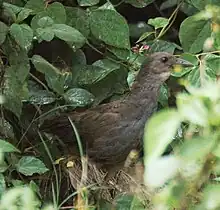Amaurornis
Amaurornis is a genus of birds in the rail family Rallidae. The species in this genus are typically called bush-hens. A monotypic subtribe, Amaurornithina, was proposed for this genus.[1]
| Amaurornis | |
|---|---|
 | |
| White-breasted waterhen (Amaurornis phoenicurus) | |
| Scientific classification | |
| Domain: | Eukaryota |
| Kingdom: | Animalia |
| Phylum: | Chordata |
| Clade: | Dinosauria |
| Class: | Aves |
| Order: | Gruiformes |
| Family: | Rallidae |
| Genus: | Amaurornis Reichenbach, 1853 |
| Type species | |
| Gallinula olivacea (Plain bush-hen) Meyen, 1834 | |
| Species | |
|
see text | |
| Synonyms | |
|
Poliolimnas Sharpe, 1893 (but see text) | |
Taxonomy
The genus Amaurornis was erected by the German naturalist Ludwig Reichenbach in 1853 with the plain bush-hen (Amaurornis olivacea) as the type species.[2] The name comes from the Greek amauros, meaning "dusky" or "brown" and ornis, meaning "bird".[3]
The New Guinea flightless rail was sometimes included in this genus, but more often held to constitute a distinct monotypic genus Megacrex. The first cladistic studies of rails, based on morphology, strongly suggested that Amaurornis as traditionally defined is not monophyletic, and that several species placed here are in fact closer to the small crakes traditionally placed in Porzana. This was subsequently confirmed by molecular data. However, these smallish species are probably not close to the large members of Porzana either, and would warrant re-establishment of the old genus Zapornia.[1][4]
Species
The genus contains five species:[5]
| Image | Scientific name | Common Name | Distribution |
|---|---|---|---|
 | Amaurornis phoenicurus | White-breasted waterhen | tropical Asia from Pakistan east to Indonesia |
 | Amaurornis olivacea | Plain bush-hen or Philippine bush-hen | Philippines |
| Amaurornis magnirostris | Talaud bush-hen | Talaud Islands, Indonesia | |
.jpg.webp) | Amaurornis isabellina | Isabelline bush-hen | Sulawesi |
 | Amaurornis moluccana | Pale-vented bush-hen, rufous-tailed bush-hen or rufous-tailed waterhen | Australia, the Moluccan Islands, New Guinea, the Bismarck Archipelago and the Solomon Islands |
References
![]() Media related to Amaurornis at Wikimedia Commons
Media related to Amaurornis at Wikimedia Commons
- Livezey, B.C. (1998). "A phylogenetic analysis of the Gruiformes (Aves) based on morphological characters, with an emphasis on the rails (Rallidae)". Philosophical Transactions of the Royal Society B. 353 (1378): 2077–2151. doi:10.1098/rstb.1998.0353. PMC 1692427.
- Reichenbach, Ludwig (1853). Handbuch der speciellen Ornithologie (in German). Vol. 1. Dresden and Leipzig: Expedition Vollständigsten Naturgeschichte. p. xxi.
- Jobling, James A. (2010). The Helm Dictionary of Scientific Bird Names. London, UK: Christopher Helm. p. 43. ISBN 978-1-4081-2501-4.
- García-R, J.C.; Gibb, G.C.; Trewick, S.A. (2014). "Deep global evolutionary radiation in birds: Diversification and trait evolution in the cosmopolitan bird family Rallidae". Molecular Phylogenetics and Evolution. 81: 96–108. doi:10.1016/j.ympev.2014.09.008.
- Gill, Frank; Donsker, David, eds. (2019). "Flufftails, finfoots, rails, trumpeters, cranes, limpkin". World Bird List Version 9.2. International Ornithologists' Union. Retrieved 8 July 2019.